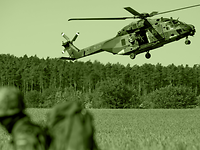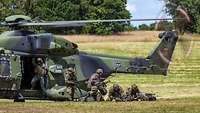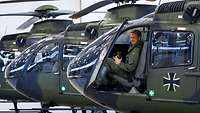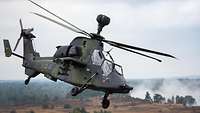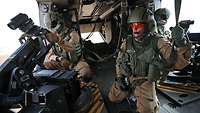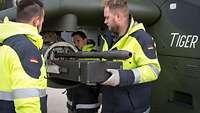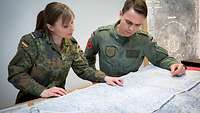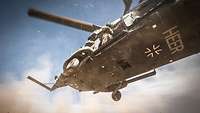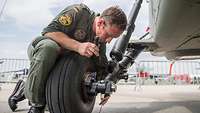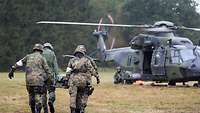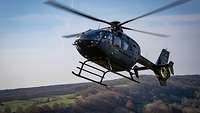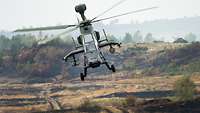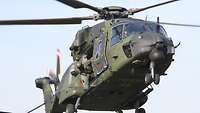Army aviation, with its organic helicopter assets and in cooperation with infantry forces, is capable of conducting air manoeuvre warfare. Additionally, it enables the exercise of airmobile command and control and reconnaissance along with combat and combat service support, including the airmobile transport of personnel, materiel and casualties. “Nach vorn!” [“Forward!”] is more than just a rallying cry: as the motto of the entire branch, it is also the guiding principle of every Army aviator.
The mainstay of air manoeuvre capability
Despite being a comparatively young branch, Army aviation is the mainstay of the Army’s air manoeuvre and air transport capabilities. Its operational units are pooled in the Rapid Response Forces Division.
One attack helicopter regiment as well as two transport helicopter regiments are directly subordinated to the Division.
The International Helicopter Training Centre in Bückeburg is an institution of central importance for the entire branch. It ranks among the most modern training facilities in the Bundeswehr and is an internationally renowned centre of excellence for helicopter pilot training. Here, all Bundeswehr helicopter pilots along with many of their comrades-in-arms from allied nations are first introduced to their future weapon systems.
More than 200 helicopters
At present, Army aviation disposes of a total of approximately 200 helicopters. These aircraft are distributed over five garrisons throughout Germany and the French-German Training Centre for Tiger Helicopter Technical and Logistic Personnel in Le Cannet-des-Maures, France.
Army aviation forces provide support to all Army branches and frequently cooperate with the other services as well as with armed forces of other nations.
They are at their most effective in high-tempo operations, bringing fires to bear on the enemy and moving forces, materiel and supplies to the designated location over short or medium distances. Their mobility allows Army aviation to make a special contribution to the manoeuvrist approach, both in general combat as well as during deep operations far into enemy territory.
During low-altitude flight, helicopters exploit the terrain and its topographic features. They do not require airfields and can, given the right equipment, fly and fight under severely limited visibility conditions or at night.
A multitude of options
Within the framework of combined-arms operations, Army aviation forces participate in peace missions, rescue and evacuation operations, special forces deployments and disaster relief operations. It is their flexibility in particular that distinguishes the Army aviation elements. Extreme weather and terrain features as well as the general conditions on the ground regularly place the highest demands on air crews, command-and-control assets and air materiel.
On operations
Army aviation forces, due to their special capabilities, have participated and continue to participate in nearly every operation abroad and disaster relief operation conducted by the German Army. These include:
1962: Hamburg flood
1991 to 1996: UNSCOMUnited Nations Special Commission in Iraq
1993 to 1994: UNOSOMUnited Nations Operation in Somalia II in Somalia
1995 to 1996: IFORImplementation Force in Yugoslavia
1996 to 1998: SFORStabilisation Force in Yugoslavia
1997: Oder river flood relief
Since 1998: KFORKosovo Force in Yugoslavia
Since 2004: EUFOREuropean Union Force in Bosnia and Herzegovina
Since 2002: ISAFInternational Security Assistance Force in Afghanistan and Uzbekistan
2002: Elbe river flood relief
2005 to 2006: Earthquake relief in Pakistan
2006: EUFOREuropean Union Force in Congo
2007: Forest fires in Greece
2011 to 2012: SFORStabilisation Force mission with Bo 105
2013: Elbe river flood relief
2013 to 2014: ISAFInternational Security Assistance Force mission, Tiger and NHNATO-Helicopter-90 employed
2017 to 2018: UNUnited Nations MINUSMAMultidimensionnelle Intégrée des Nations Unies pour la Stabilisation au Mali mission in Mali, Tiger and NHNATO-Helicopter-90 employed
Army aviation elements may depart from their basic organisational structure and form mixed Army aviation units that employ different aircraft. These mixed units can be assigned to the operational control of the national commander in theatre, which is why flying command personnel must have mastered the operational doctrine of all Army aviation weapon systems.
